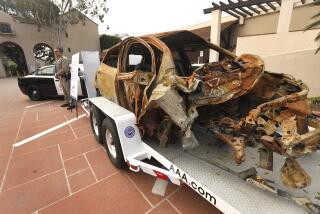Clinton Calls for Stricter Law on Drunken Driving
- Share via
WASHINGTON — President Clinton on Saturday called on Congress to enact stricter drunken driving laws and released a federal study showing that more than a quarter of all U.S. drivers have used drugs, alcohol or both within two hours of getting behind the wheel of a car.
During the season when many people indulge in alcohol at parties, Clinton pointed out that in December 1997, more than 1,300 people in the U.S. died in alcohol-related car crashes. “Who knows how many presents under the Christmas tree were left unopened; presents for a child killed by a drunk driver?” he said in his weekly radio address.
He said he will again urge lawmakers to lower the national blood-alcohol limit for drunken driving to 0.08% from the current 0.1%, an idea Congress rejected earlier this year. The proposal is designed to push states to follow suit.
Clinton’s plan would allow states three years to impose the lower limit or risk losing federal highway funds. Currently, 16 states, including California, and the District of Columbia maintain the lower limit.
He noted that alcohol-related road deaths reached their lowest level last year, at 16,189, since the government began keeping records in 1975. Also, the rate of alcohol-involved accidents fell from nearly 41% of all mishaps on U.S. roads in 1996 to 38.6% in 1997, the first time the percentage dropped below 40%.
But the president said more needs to be done.
“For a generation, drunk driving has been one of America’s greatest public safety challenges,” he said. “The sight of a car weaving through traffic is an all too familiar and frightening one for many Americans.”
The Senate earlier this year approved the 0.08% standard, but the House balked, deleting the provision from the six-year highway spending bill Congress passed in May.
Clinton said the departments of Justice and Transportation would also beef up their efforts--through grants to states and other incentives--to enforce underage drinking laws, to carry out alcohol-impaired driving prevention programs and to pass and enforce strong state highway safety legislation.
One new federal rule would revise the criteria for receiving money from the Alcohol-Impaired Driving Grant Incentive Program, including testing blood-alcohol levels of drivers in fatal crashes and setting up programs to target drinking and driving by young adults.
Clinton said the Justice Department would make $25 million available to the states to curb underage drinking by supporting the enforcement of laws that prohibit the sale and consumption of alcohol by minors.
About one-third of all motor vehicle fatalities involving drivers ages 15 to 20 are alcohol-related, according to federal officials.
The new federal study cited by the president reported that 28% of the nation’s estimated 166 million drivers drank alcohol, used drugs or indulged in both within two hours of driving.
Also, the study found that driving after drug use is more common among male drivers ages 16 to 20, and that alcohol use is more common among older drivers.
The study was conducted by the Substance Abuse and Mental Health Services Administration, part of the Department of Health and Human Services, and the Department of Transportation, as part of the government’s 1996 National Household Survey on Drug Abuse. The agencies conducted face-to-face interviews with 11,847 drivers.
“Too often, a season that should be joyful and renewing becomes instead a season of tragedy,” said HHS Secretary Donna Shalala. “We can all take steps to prevent drunk and drugged driving, and we owe it to ourselves and others to take those steps.”
Dr. Ricardo Martinez, administrator of the National Highway Traffic Safety Administration, agreed, calling impaired driving “the most frequently committed violent crime in America,” causing more than 16,000 deaths and costing $45 billion annually.
Federal officials recommended that all hosts provide nonalcoholic drinks as a safe choice for partygoers who will be driving.
According to the new study:
* An estimated 23% of drivers used alcohol within two hours of driving; 5% operated a motor vehicle within two hours after drug use with or without alcohol;
* Marijuana was the illicit drug used most often by those who drove after drug use, used by 70% of such drivers. A majority of those marijuana users claimed the drug did “not at all” affect their ability to drive safely;
* Among all those surveyed, driving after drinking alcohol was more common among men (31%) than among women (14%).
More to Read
Sign up for Essential California
The most important California stories and recommendations in your inbox every morning.
You may occasionally receive promotional content from the Los Angeles Times.













